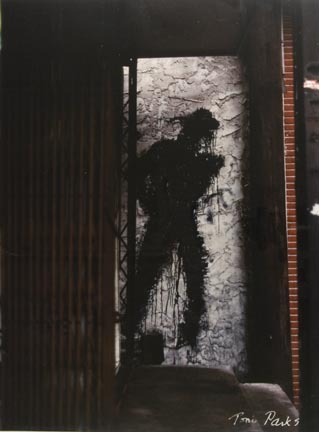About the Photographer
Parks, Toni
American, b. 1941 Minneapolis, MN
As the daughter of legendary photographer Gordon Parks, Toni Parks grew up in a household where artists and literary giants were regular visitors. Her two brothers, Gordon Parks, Jr. and David Parks, became photographers earlier in life while Toni started her photographic career in her forties. She counts her father as a major influence, as well as her background as a trained composer and musician.
During her most prolific years of the 1980s and 90s, Parks took her first assignments covering a theater production on Martin Luther King, Jr., documenting dancers and singers at New York City’s Lincoln Center, and exploring the streets of New York City with her camera in hand. Statues in Central Park, Harlem parade scenes, and everyday depictions of individual or group subjects comprise Parks’ early body of work, often created with the compositional advice of her father in mind.
In Parks’ Graffiti Man (1994), the life-sized figure, found in a subway station and described by Parks as a man waiting to pounce, is one of a number of Parks’ photographs featuring graffiti in New York City in the early 1990s. With impeding events leading up to the 1995 Anti-Graffiti Task Force, Parks’ Graffiti Man can be considered within the context of a changing artistic expression for which, in the early 1970s, NYC became the center. A massive overhaul to eliminate what was regarded as a nuisance to city officials resulted in severe repercussions for graffiti artists and the whitewashing of the full range of graffiti arts, all created outside the jurisdiction of city sanctioned art spaces and projects. The secluded nature of Graffiti Man is in stark contrast with much of the large and visible graffiti creations marking urban areas, suggesting the pervasive changes taking place at this moment in New York’s history.
Graffiti Man coincides with a time in Parks’ career in which, starting in 1993, she became part of the photography collective, Kamoinge. Founded in 1963 by Roy DeCarava and others, Kamoinge is comprised of photographers acutely aware of the under-representation of black photographers in photojournalism and the art world. Its membership of over twenty mostly New York-based photographers includes new and more established figures with diverse stylistic and thematic allegiances. Parks is among the small but growing number of women to join the invitation-only group, whose activities include critiquing members’ work, building an archive, and participating in exhibitions.
Within her own expansive history of exhibitions in the United States and England, Parks’ work is often considered in constellation with other photographers, most notably her father. Whether presented as a homage or positioned as a visual kinship and conversation between the two, exhibitions such as Songs for My Father (2001) shown at locations including the College at New Rochelle, New York, link father and daughter in order to illustrate the range of ways Gordon Parks’ work serves as a constant reference point and touchstone for Toni Parks’ respective career.
Toni Parks was born 1941 in Minneapolis, Minnesota, raised in White Plains, NY, and attended the Boston Conservatory of Music. She currently resides in Devon, England. Other solo exhibitions include I Sight II (1995) at the Covenant House, New York, and Toni Parks (2005) at the Wilmer Jennings Gallery at Kenkeleba, New York.
